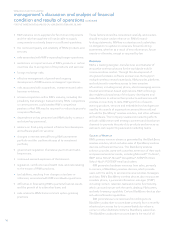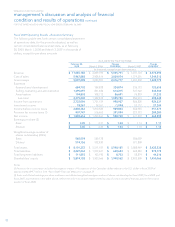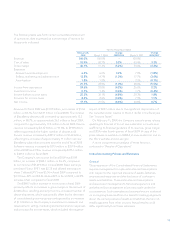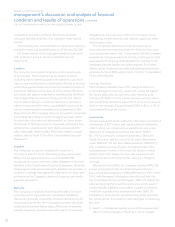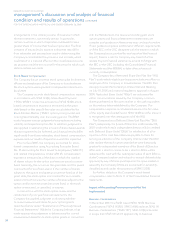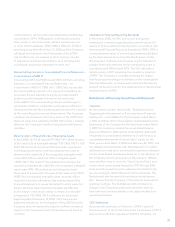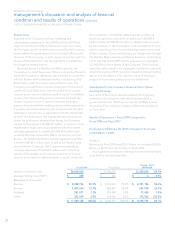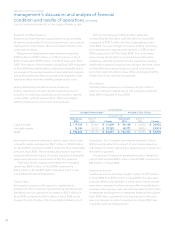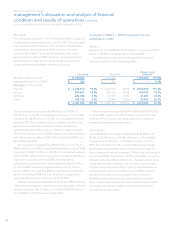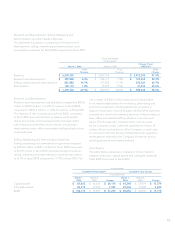Blackberry 2009 Annual Report Download - page 25
Download and view the complete annual report
Please find page 25 of the 2009 Blackberry annual report below. You can navigate through the pages in the report by either clicking on the pages listed below, or by using the keyword search tool below to find specific information within the annual report.23
the financial reporting and tax basis of assets and liabilities,
including research and development costs and incentives,
capital assets, non-deductible reserves and operating loss
carryforwards, net of valuation allowances. The Company
considers both positive evidence and negative evidence, to
determine whether, based upon the weight of that evidence,
a valuation allowance is required. Judgment is required in
considering the relative impact of negative and positive
evidence. The Company records a valuation allowance
to reduce deferred income tax assets to the amount
management considers to be more likely than not to be
realized. If the Company determines that it is more likely than
not that it will not be able to realize all or part of its deferred
income tax assets in future fiscal periods, the valuation
allowance would be increased, resulting in a decrease to net
income in the reporting periods when such determinations
are made.
The Company uses the flow-through method to account
for investment tax credits (“ITCs”) earned on eligible scientific
research and experimental development expenditures.
The Company applies judgement in determining which
expenditures are eligible to be claimed. Under this method,
the ITCs are recognized as a reduction to income tax
expense.
Significant judgment is required in evaluating the
Company’s uncertain tax positions and provision for income
taxes. The Company uses Financial Accounting Standards
Board (“FASB”) Interpretation No. 48, Accounting for
Uncertainty in Income Taxes (“FIN 48”) in assessing its
uncertain tax positions and provision for income taxes.
FIN 48 clarifies the accounting for uncertainty in income
taxes recognized in an enterprise’s financial statements
in accordance with SFAS No. 109, Accounting for Income
Taxes, and prescribes a recognition threshold of more likely
than not to be sustained upon examination. In addition,
FIN 48 provides guidance on derecognition, measurement,
classification, interest and penalties, accounting in interim
periods and disclosure and transitions. For further details,
refer to Note 9 to the Consolidated Financial Statements.
The Company’s provision for income taxes is based on
a number of estimates and assumptions as determined by
management and is calculated in each of the jurisdictions
in which it conducts business. The Company’s consolidated
income tax rates have differed from statutory rates primarily
due to the tax impact of ITCs, manufacturing activities,
foreign exchange differences, the amount of net income
earned in Canada versus other operating jurisdictions and
the rate of taxes payable in respect of those other operating
jurisdictions. The Company enters into transactions and
• Level 2 — Observable inputs other than quoted prices
included in Level 1, such as quoted prices for similar
assets and liabilities in active markets, quoted prices for
identical or similar assets and liabilities in markets that are
not active, or other inputs that are observable or can be
corroborated by observable market data.
• Level 3 — Significant unobservable inputs that are
supported by little or no market activity.
Given the current market conditions and economic
uncertainties, management exercises significant judgment in
determining the fair value of the Company’s investments and
the investment’s classification level within the three-tier fair
value hierarchy. The fair value hierarchy also requires an entity
to maximize the use of observable inputs and minimize the
use of unobservable inputs when measuring fair value. As at
February 28, 2009, the Company had approximately 97% of its
available-for-sale investments measured at fair value classified
in Level 2.
The Company regularly assesses declines in the value of
individual investments for impairment to determine whether
the decline is other-than-temporary. The Company makes
this assessment by considering available evidence, including
changes in general market conditions, specific industry
and individual company data, the length of time and the
extent to which the market value has been less than cost, the
financial condition, the near-term prospects of the individual
investment and the Company’s intent and ability to hold the
investments to maturity. In the event that a decline in the
fair value of an investment occurs and the decline in value
is considered to be other–than-temporary, an appropriate
write-down would be recorded. The Company’s assessment
on whether an investment is other-than-temporarily impaired
or not, could change due to new developments or changes in
assumptions or risks to any particular investment.
For further details on the Company’s investments and
fair value conclusions, refer to Note 4 and Note 17 to the
Consolidated Financial Statements.
Income taxes
In accordance with SFAS 109, Accounting for Income Taxes,
the Company uses the liability method of tax allocation
to account for income taxes. Under this method, deferred
income tax assets and liabilities are determined based upon
differences between the financial reporting and tax bases
of assets and liabilities and are measured using enacted tax
rates and laws that will be in effect when the differences are
expected to reverse. The Company’s deferred income tax
asset balance represents temporary differences between





